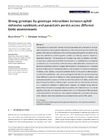Strong genotype-by-genotype interactions between aphid-defensive symbionts and parasitoids persist across different biotic environments
dc.contributor.author
Gimmi, Elena
dc.contributor.author
Vorburger, Christoph
dc.date.accessioned
2022-01-13T20:10:17Z
dc.date.available
2021-11-13T07:54:46Z
dc.date.available
2021-11-15T21:19:05Z
dc.date.available
2022-01-13T20:10:17Z
dc.date.issued
2021-12
dc.identifier.issn
1010-061X
dc.identifier.issn
1420-9101
dc.identifier.other
10.1111/jeb.13953
en_US
dc.identifier.uri
http://hdl.handle.net/20.500.11850/515000
dc.identifier.doi
10.3929/ethz-b-000515000
dc.description.abstract
The dynamics of coevolution between hosts and parasites are influenced by their genetic interactions. Highly specific interactions, where the outcome of an infection depends on the precise combination of host and parasite genotypes (G x G interactions), have the potential to maintain genetic variation by inducing negative frequency-dependent selection. The importance of this effect also rests on whether such interactions are consistent across different environments or modified by environmental variation (G x G x E interaction). In the black bean aphid, Aphis fabae, resistance to its parasitoid Lysiphlebus fabarum is largely determined by the possession of a heritable bacterial endosymbiont, Hamiltonella defensa, with strong G x G interactions between H. defensa and L. fabarum. A key environmental factor in this system is the host plant on which the aphid feeds. Here, we exposed genetically identical aphids harbouring three different strains of H. defensa to three asexual genotypes of L. fabarum and measured parasitism success on three common host plants of A. fabae, namely Vicia faba, Chenopodium album and Beta vulgaris. As expected, we observed the pervasive G x G interaction between H. defensa and L. fabarum, but despite strong main effects of the host plants on average rates of parasitism, this interaction was not altered significantly by the host plant environment (no G x G x E interaction). The symbiont-conferred specificity of resistance is thus likely to mediate the coevolution of A. fabae and L. fabarum, even when played out across diverse host plants of the aphid.
en_US
dc.format
application/pdf
en_US
dc.language.iso
en
en_US
dc.publisher
Wiley
en_US
dc.rights.uri
http://creativecommons.org/licenses/by/4.0/
dc.subject
aphids
en_US
dc.subject
defensive symbiosis
en_US
dc.subject
genotype-by-genotype interactions
en_US
dc.subject
Host–parasite coevolution
en_US
dc.subject
parasitoids
en_US
dc.subject
resistance
en_US
dc.title
Strong genotype-by-genotype interactions between aphid-defensive symbionts and parasitoids persist across different biotic environments
en_US
dc.type
Journal Article
dc.rights.license
Creative Commons Attribution 4.0 International
dc.date.published
2021-10-25
ethz.journal.title
Journal of Evolutionary Biology
ethz.journal.volume
34
en_US
ethz.journal.issue
12
en_US
ethz.journal.abbreviated
J Evol Biol
ethz.pages.start
1944
en_US
ethz.pages.end
1953
en_US
ethz.version.deposit
publishedVersion
en_US
ethz.identifier.wos
ethz.identifier.scopus
ethz.publication.place
Oxford
en_US
ethz.publication.status
published
en_US
ethz.date.deposited
2021-11-13T07:56:53Z
ethz.source
WOS
ethz.eth
yes
en_US
ethz.availability
Open access
en_US
ethz.rosetta.installDate
2022-01-13T20:10:25Z
ethz.rosetta.lastUpdated
2024-02-02T15:59:45Z
ethz.rosetta.versionExported
true
ethz.COinS
ctx_ver=Z39.88-2004&rft_val_fmt=info:ofi/fmt:kev:mtx:journal&rft.atitle=Strong%20genotype-by-genotype%20interactions%20between%20aphid-defensive%20symbionts%20and%20parasitoids%20persist%20across%20different%20biotic%20environments&rft.jtitle=Journal%20of%20Evolutionary%20Biology&rft.date=2021-12&rft.volume=34&rft.issue=12&rft.spage=1944&rft.epage=1953&rft.issn=1010-061X&1420-9101&rft.au=Gimmi,%20Elena&Vorburger,%20Christoph&rft.genre=article&rft_id=info:doi/10.1111/jeb.13953&
Files in this item
Publication type
-
Journal Article [128830]

